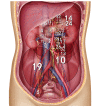Diagnosis and surgical treatment of retroperitoneal paraganglioma: A single-institution experience of 34 cases
- PMID: 28789448
- PMCID: PMC5530091
- DOI: 10.3892/ol.2017.6468
Diagnosis and surgical treatment of retroperitoneal paraganglioma: A single-institution experience of 34 cases
Abstract
The present study aimed at identifying the clinical, radiological and pathological characteristics of retroperitoneal paragangliomas, and determining the association between the tumor features and the prognosis of patients following surgery. A total of 34 patients with retroperitoneal paragangliomas, who underwent resection between November 1999 and December 2015, were included in the present retrospective study. The patients' demographics, clinical symptoms and signs, tumor functional status, surgical procedure, intraoperative results, tumor pathology, radiological results, and postoperative survival time were recorded and analyzed. Of the 34 patients, the most common type of presenting symptom was abdominal mass (46%), followed by hypertension (39%) and abdominal pain (32%). Functional tumors occurred in 20 patients (59%). Computed tomography (CT) and magnetic resonance imaging revealed soft-tissue masses, with marked enhancement in the arterial phase, indicative of retroperitoneal paragangliomas. The preoperative CT diagnostic accuracy rate between 2010 and 2015 was markedly improved, compared with that between 1999 and 2009. The tumors were primarily located close to the renal arteries and veins surrounding the abdominal aorta and inferior vena cava. With the exception of one malignant paraganglioma, the majority of paragangliomas were positive for chromogranin A, S-100 protein, vimentin and heat-shock protein 90, and exhibited decreased expression of Ki-67 antigen and insulin-like growth factor 2. All tumors were completely removed by surgery. Distant metastasis, but not tumor size, functional status and local invasion, was markedly associated with survival. The preoperative diagnostic accuracy rate of retroperitoneal paragangliomas may be improved by focusing on the predilection sites and CT characteristics. In addition, immunohistochemical markers were useful to determine tumor malignancy. Complete surgical resection was appropriate for all patients and postoperative survival time was identified to be associated with tumor metastasis.
Keywords: paraganglioma; retroperitoneal tumor; surgical resection; survival time.
Figures





References
-
- Noda T, Nagano H, Miyamoto A, Wada H, Murakami M, Kobayashi S, Marubashi S, Takeda Y, Dono K, Umeshita K, et al. Successful outcome after resection of liver metastasis arising from an extraadrenal retroperitoneal paraganglioma that appeared 9 years after surgical excision of the primary lesion. Int J Clin Oncol. 2009;14:473–477. doi: 10.1007/s10147-008-0872-1. - DOI - PubMed
-
- Sclafani LM, Woodruff JM, Brennan MF. Extraadrenal retroperitoneal paragangliomas: Natural history and response to treatment. Surgery. 1990;108:1124–1130. - PubMed
LinkOut - more resources
Full Text Sources
Other Literature Sources
Research Materials
